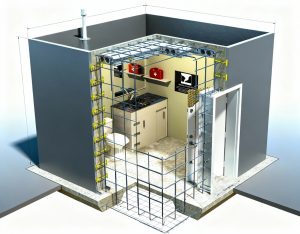Understanding Expansion Behavior in Large-Scale Cisterns
In most cistern liner conversations, the focus tends to stay on coating type or food-grade compliance. Less time is spent on how the substrate itself behaves—especially in tanks exposed to daily or seasonal thermal shifts. Inside a large concrete cistern, temperature gradients from sunlight, buried depth, or fill cycles can cause the structure to expand at different rates in different zones. Over time, this behavior doesn’t just strain the tank—it directly affects the integrity of the cistern coating bonded to it.
A sprayed liner system, even one as adaptable as a polyurea cistern, must absorb and redistribute this movement without peeling. And yet, few field guides train crews to measure this effect before application.
Where Movement Begins and Why It Spreads
Most water storage tanks don’t expand uniformly. A cistern storage tank installed partially underground may remain cooler at the base than near the top of the tank. When irrigation water flows in from a surface line on a hot day, that temperature differential pulls tension across the internal coating. Tanks used for potable water storage can also experience this when filled rapidly after being empty in high heat. The result shows up not in cracking but in microdelamination—where sections of the liner coating begin to lift from the substrate in small areas that may remain invisible during inspection.
Industry experts refer to this as edge ripple or panel memory, depending on the shape of the delaminated area. The long-term effect becomes clear only after seasonal cycles have repeated and the liner material has softened or separated just enough to allow moisture to seep beneath the coating.
Why Custom Cistern Liners Must Follow Tank Behavior
Pre-made liner solutions often fail to consider how each tank actually performs. This includes not only size and shape, but also wall thickness, tank age, and proximity to heat or cold sources. Custom Cistern Liners must respond to real-world movement—not just fit to exact dimensions on a blueprint. For tanks made from stainless steel, this might mean adding movement joints or flexible top seals. In ground tanks made from concrete or block, it may mean adjusting spray thickness at known stress points or applying backup edge reinforcement in the floor-to-wall transition zone.
In either case, understanding movement leads to better decisions on liner material, thickness, and edge termination. And those adjustments—though simple in appearance—make the difference between a coating that peels in five years and one that earns its place as a long-lasting, cost-effective solution.
Why Drop-In Liners Behave Differently in Dynamic Environments
Drop-in liners offer one advantage in thermally active tanks: they move freely. Because they don’t bond to the surface, they expand and contract with the tank’s structure and water load. But drop-ins come with their own challenges. They must match the internal shape of the tank without folds, which often means trimming and anchoring to precise tolerances. In larger bulk storage tanks with poor access, even small measurement errors can cause misalignment or ballooning during fill cycles.
This is where trained installers must consider not just cistern liner types but also tank history. Has the tank held drinking water? Has it ever been repaired? What materials have touched the surface before? Understanding these details leads to smarter liner prep—and ultimately, better outcomes.
Matching Food-Grade Coatings to Tank Use Patterns
In tanks used for drinking water, even minor failures in the liner system can lead to regulatory problems or health concerns. The coating must not only meet food grade standards but must also maintain that classification through age, chemical exposure, and seasonal use. A liner applied during a dry period may lose adhesion during the wet season if the tank wall begins to sweat or the temperature drops suddenly. Cistern Tank Liner Features must accommodate this kind of fluctuation. Otherwise, performance becomes inconsistent.
Some installers rely on products like Fab-Seal for potable water storage due to their adaptability, but even these systems require attention to local tank behavior. Matching use patterns to product performance—rather than just picking for price or availability—remains the best way to protect the lifespan of the liner.
Conclusion
Coating applications for cistern liners must take surface dynamics seriously. That includes movement, moisture, and thermal expansion—especially in tanks that shift slightly but repeatedly. Polyurea and polyurethane systems offer excellent coverage, but only when applied with an understanding of how the substrate will behave after the job ends. Training, planning, and observation matter more than material spec sheets. In this way, the most effective liner becomes not the thickest or the cheapest—but the one that listens to the tank before it seals it. Because in cistern work, what moves quietly often defines what lasts.






